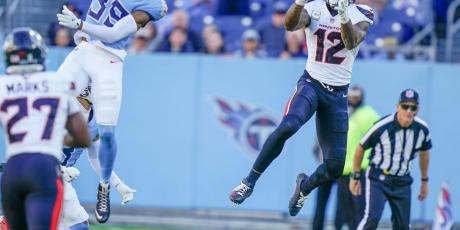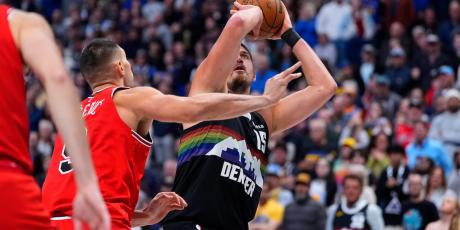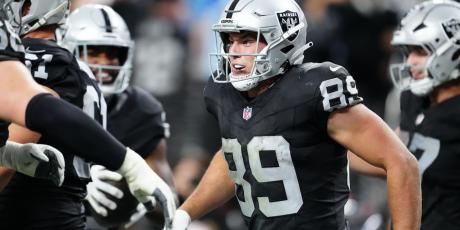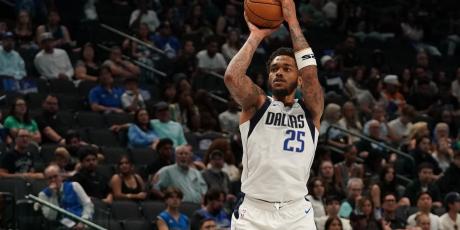Guide to DFS Bankroll Management: Risk Management

This isn’t going to be a bankroll lesson in exactly how much money you should put into play. That advice has been written and discussed multiple times over. Rather, this is going to tie bankroll back to your goals, specifically knowing who you are as a player, and give you an idea of what to expect from various bankroll approaches to daily fantasy football.
The Risk Averse
The risk-averse owner will do everything in his power to not have a losing NFL DFS season, including never playing more than 10 percent of his bankroll in a given week and putting only 10 percent of his weekly money in large-field tournaments.
More in the DFS Bankroll Management series: Game Selection | Setting Goals
Though this is a very safe approach to bankroll management, not being aggressive enough can be a DFS pitfall. There are worse people to be than the risk-averse player, but unless you are in the infancy of a full-time DFS career or have no way to replenish funds if you lose a sizeable chunk of your bankroll, a strict risk-averse strategy often limits downside in favor of some major +EV upside opportunities. Most DFS players are playing with expendable income and can replenish at least a decent portion of their bankroll if needed.
The Risk Taker
While we often hear the success stories of throwing caution to the wind and coming out on top, few people ever talk about the players who fell flat on their face trying or lost it all because they had no discipline.
There is probably a case to be made for the possibility of a full-time DFS tournament player, but when it comes to exclusively playing daily fantasy football, there are simply not enough trials to throw all, or most, of your money at GPPs as it can be nearly impossible to recognize your tournament edge if you only play NFL DFS. Consider this quote from Jonathan Bales in his book “How to Win at Daily Fantasy Sports”:
“If you have a normal distribution of tournament finishes and a 20 percent long-term ROI, you still have somewhere around a 16 percent chance of being down after a sample of 1,000 GPPs. You read that correctly. If you are a big long-term winner and play one tournament lineup per week, you have somewhere around a one-in-six chance of still being down after 62.5 seasons of NFL action.”
Down after 62.5 NFL seasons! Sure you can play more lineups per week but the point remains that there is an extremely high level of risk on a weekly basis and throwing all of your money at tournaments can be devastating in a single NFL season.
If you are going to be the risk taker, you have to go into the season knowing that there is a very real chance that you end Week 17 down every dollar that you put in. In DFS, it’s often a good thing to be exposed to upside, but it’s also important to avoid the risk of absolute ruin.
The Perfect Balance
This player is the perfect balance of risk management and exposure to upside. This player sticks to a strict, well-thought-out plan. For some players, this perfect balance might be making just enough money in their head-to-heads and 50/50s to pay for their GPPs. For others, it might mean steady bankroll growth with a strict 15 percent cap for their weekly money in play in large field tournaments. This seems like the perfect player to be, and for most DFS players, it may very well be.
The one drawback to keeping a perfect balance is that a rigid weekly bankroll formula might still leave some upside opportunities (or downside traps) on the table. It takes a trained eye to spot these (un)favorable circumstances, which is why the perfect balance is probably the right player to be for most people. You can still take home a big win, it might just take a while to get there.
The Great Freestyler
The ultimate bankroll manager is someone who can go into every week and recognize that week’s unique money-making opportunities, or lack thereof. Here’s my most glaring example of a situation where a specific week dictated that I pull in the bankroll reigns more than ever:
It was the middle of the season and DraftKings had significantly loosened up salaries on NFL contests, to the point where you could virtually roster a top-five player at every position. I took to Twitter to advise followers to significantly cut back, or not even play cash games with such loose salaries, with the logic being that with every owner able to roster multiple studs, the edge of properly evaluating player value is greatly diminished.
A fellow DFS writer, whose advice I seek out weekly and consider one of the best players in the world, contended that because we still have some edge and other owners will make the same mistakes that they always make, that we should keep our volume consistent.
That week, with so many studs in every lineup, the average winning score in 50/50s was well over 165 DK points. Leading up to that week, targeting a cash-game lineup that could even approach 150 points was almost a lock for a profitable week. Without the need to effectively evaluate value plays, cash games became a crap shoot hinging on which studs had monster weeks, and even poor DFS players stumbled into good lineups. More than a few daily fantasy players came to me afterward to let me know that it was one of their worst NFL weeks to date.
I didn’t tell that story to tell you I won an argument. It’s simply an example of why having a strict bankroll plan can have some pitfalls. Just like with my weekly approach to building lineups, I want fluidity in my weekly bankroll management. I want to be a great freestyler. There are also many examples of when extending your weekly bankroll limits might be plausible.
If I’m going to stretch my bankroll limits, I’m looking for two things: An increased skill advantage or a chance at “free money”. These topics will be covered more in-depth in the lesson on game selection, but I’ll give a few examples.
Since I argued that I want to play less cash-game volume when salaries are loose, it’s logical that I generally want to play more of my bankroll with tight salaries. When it’s difficult for an experienced player to put together a lineup, imagine what a novice player is going through. I also want to play when there is going to be an influx of mediocre players. The largest tournaments attract the biggest gamblers and early in the season, everyone has the most money to throw around.
Some examples of “free money” situations are when sites are offering freerolls or bonuses, or there is overlay on a number of tournaments. Again, I will touch on these topics specifically in the game selection lessons, but these are all spots where our expected value of a game is higher than usual simply by entering said contest.
Deciding Who You Are
As I discussed in the goal-setting lesson, accurate self-evaluation is critical in daily fantasy football. No matter your bankroll persona, playing within your means is the most important bankroll rule of all. Unless you have unlimited funds, being an absolute risk taker is the most disastrous path to take, especially for a novice daily fantasy football player. On the flip side, the risk-averse owners are greatly minimizing their chances of optimal DFS success—for what it’s worth if you are on a limited bankroll, I highly suggest this approach.
If you have properly prepared yourself and have a decent amount of experience playing DFS, having a perfect bankroll balance is great, but it’s best to be fluid in your bankroll decisions. Beware though: The freedom to vary bankroll strategy can potentially lead to bad justifications for poor bankroll management. If this is your first season playing daily fantasy football, it’s probably best to stick to a strict plan.
In the final lesson on building a unique bankroll strategy, I will discuss game selection as it pertains to specific aspects of DFS.


















